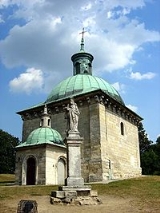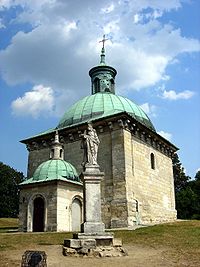
Santi Gucci
Encyclopedia
Santi Gucci was a Polish-Italian architect and sculptor.

, and became the court artist of king Sigismund II Augustus of Poland, his queen consort Anna Jagiellonka and his successor Stefan Batory of Poland. Santi Gucci's workshop in Pińczów
became a notable school which attracted many future artists and became one of the centres of Mannerist
art and culture in Poland
. For his merits for the Polish crown he was ennobled, accepted into the ranks of the szlachta
and given a Zetynian Coat of Arms.
One of the most successful and fruitful artists of his epoch, Gucci built or reconstructed a number of palaces of notable people in all parts of the Polish Republic
. Among them was the Firlej
family castle in Janowiec
on the Vistula
(1565–1585), for whom he also sculpted a Mannerist tomb in a local parish church (ca. 1586). For the Myszkowski family he erected a new palace in Książ
(1585–1595), which however has not survived to our times. He also erected the Łobzów palace (1585–1587), in Kraków
, and expanded the castle in Pińczów
(1591–1600). He is also supposed to be the architect of the Pińczów synagogue
.
One of his most notable works is the integral design and funerary monuments in the Bartolommeo Berrecci
's Sigismund's Chapel in the Wawel Cathedral
. The chapel, often referred to as the pearl of Italian Renaissance north of the Alps, housed the graves of King Sigismund Augustus of Poland and Anna Jagiellonka. Between 1594 and 1595 he also refurbished the Mariacka Chapel to house the tomb of Stefan Batory
. Others among his major works include the Branicki
family chapel in Niepołomice (1596) and St. Anne's Chapel
in Pińczów
.

Biography
He moved to Poland after 1550, most probably from FlorenceFlorence
Florence is the capital city of the Italian region of Tuscany and of the province of Florence. It is the most populous city in Tuscany, with approximately 370,000 inhabitants, expanding to over 1.5 million in the metropolitan area....
, and became the court artist of king Sigismund II Augustus of Poland, his queen consort Anna Jagiellonka and his successor Stefan Batory of Poland. Santi Gucci's workshop in Pińczów
Pinczów
Pińczów is a town in Poland, in Świętokrzyskie Voivodship, about 40 km south of Kielce. It is the capital of Pińczów County. Population is 12,304 .-History:...
became a notable school which attracted many future artists and became one of the centres of Mannerist
Mannerism
Mannerism is a period of European art that emerged from the later years of the Italian High Renaissance around 1520. It lasted until about 1580 in Italy, when a more Baroque style began to replace it, but Northern Mannerism continued into the early 17th century throughout much of Europe...
art and culture in Poland
Poland
Poland , officially the Republic of Poland , is a country in Central Europe bordered by Germany to the west; the Czech Republic and Slovakia to the south; Ukraine, Belarus and Lithuania to the east; and the Baltic Sea and Kaliningrad Oblast, a Russian exclave, to the north...
. For his merits for the Polish crown he was ennobled, accepted into the ranks of the szlachta
Szlachta
The szlachta was a legally privileged noble class with origins in the Kingdom of Poland. It gained considerable institutional privileges during the 1333-1370 reign of Casimir the Great. In 1413, following a series of tentative personal unions between the Grand Duchy of Lithuania and the Kingdom of...
and given a Zetynian Coat of Arms.
One of the most successful and fruitful artists of his epoch, Gucci built or reconstructed a number of palaces of notable people in all parts of the Polish Republic
Rzeczpospolita
Rzeczpospolita is a traditional name of the Polish State, usually referred to as Rzeczpospolita Polska . It comes from the words: "rzecz" and "pospolita" , literally, a "common thing". It comes from latin word "respublica", meaning simply "republic"...
. Among them was the Firlej
Firlej
Firlej is a village in Lubartów County, Lublin Voivodeship, in eastern Poland. It is the seat of the gmina called Gmina Firlej. It lies approximately north-west of Lubartów and north of the regional capital Lublin...
family castle in Janowiec
Janowiec
Janowiec is a village in Puławy County, Lublin Voivodeship, in eastern Poland. It is the seat of the gmina called Gmina Janowiec. It lies approximately south-west of Puławy and west of the regional capital Lublin. The village has a population of 1,000.It received its town charter in 1537, but...
on the Vistula
Vistula
The Vistula is the longest and the most important river in Poland, at 1,047 km in length. The watershed area of the Vistula is , of which lies within Poland ....
(1565–1585), for whom he also sculpted a Mannerist tomb in a local parish church (ca. 1586). For the Myszkowski family he erected a new palace in Książ
Ksiaz
Książ is a castle in Silesia, Poland near the town of Wałbrzych. It was built in 1288-1292 under Bolko I the Strict. It lies within a protected area called Książ Landscape Park.- History :...
(1585–1595), which however has not survived to our times. He also erected the Łobzów palace (1585–1587), in Kraków
Kraków
Kraków also Krakow, or Cracow , is the second largest and one of the oldest cities in Poland. Situated on the Vistula River in the Lesser Poland region, the city dates back to the 7th century. Kraków has traditionally been one of the leading centres of Polish academic, cultural, and artistic life...
, and expanded the castle in Pińczów
Pinczów
Pińczów is a town in Poland, in Świętokrzyskie Voivodship, about 40 km south of Kielce. It is the capital of Pińczów County. Population is 12,304 .-History:...
(1591–1600). He is also supposed to be the architect of the Pińczów synagogue
Pinczów synagogue
Pińczów synagogue is a Jewish synagogue in Pińczów in Poland.It is one of the oldest synagogues in Poland, built in 1594-1609. The designer was probably the Florentian Santi Gucci. During World War II it was vandalized by the Nazi Germans, then damaged during fighting in 1944, and it is inactive...
.
One of his most notable works is the integral design and funerary monuments in the Bartolommeo Berrecci
Bartolommeo Berrecci
Bartolommeo Berrecci was a Florentine renaissance architect, who spent most of his career in Poland.He learned architecture in Florence, probably taught by Andrea Ferrucci...
's Sigismund's Chapel in the Wawel Cathedral
Wawel Cathedral
The Wawel Cathedral, also known as the Cathedral Basilica of Sts. Stanisław and Vaclav, is a church located on Wawel Hill in Kraków–Poland's national sanctuary. It has a 1,000-year history and was the traditional coronation site of Polish monarchs. It is the Cathedral of the Archdiocese of Kraków...
. The chapel, often referred to as the pearl of Italian Renaissance north of the Alps, housed the graves of King Sigismund Augustus of Poland and Anna Jagiellonka. Between 1594 and 1595 he also refurbished the Mariacka Chapel to house the tomb of Stefan Batory
Stefan Batory
Stephen Báthory was a Hungarian noble Prince of Transylvania , then King of Poland and Grand Duke of Lithuania . He was a member of the Somlyó branch of the noble Hungarian Báthory family...
. Others among his major works include the Branicki
Branicki
Branicki can refer to:* two aristocratic families of Poland :** Branicki family, Gryf Coat of Arms** Branicki family, Korczak Coat of Arms* individuals bearing Branicki surname:**Franciszek Ksawery Branicki...
family chapel in Niepołomice (1596) and St. Anne's Chapel
St Anne's Chapel
St Anne's Chapel is a chapel in the city of Pińczów in Poland. It was designed by Santi Gucci and built in 1600, on the slopes of the St. Anne's Hill overlooking the town. Rectangular in shape, the chapel is a distinctive example of mannerist architecture, the temple was financed by a local noble,...
in Pińczów
Pinczów
Pińczów is a town in Poland, in Świętokrzyskie Voivodship, about 40 km south of Kielce. It is the capital of Pińczów County. Population is 12,304 .-History:...
.

